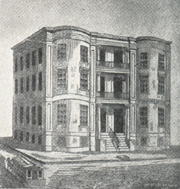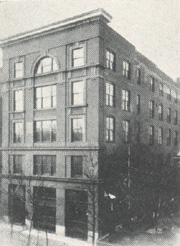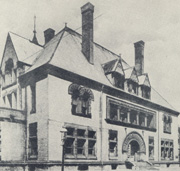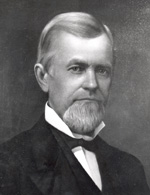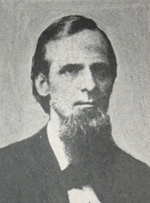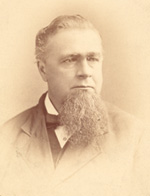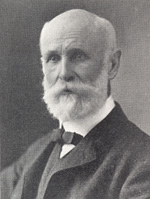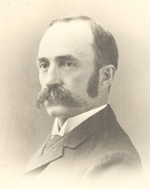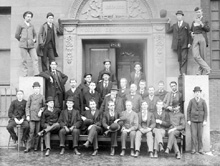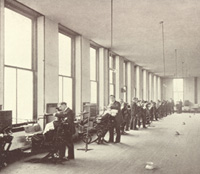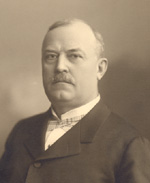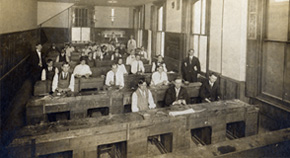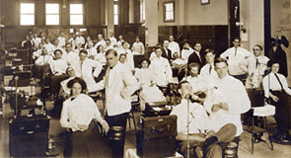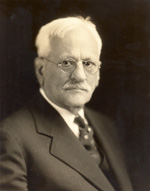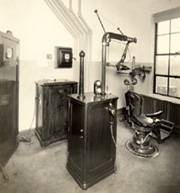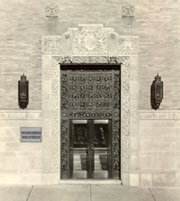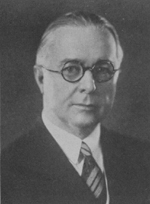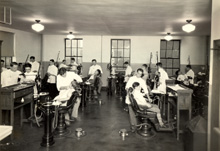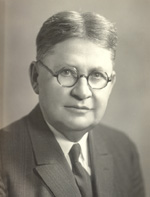| Home History Biographies Faculty & Alumni Timeline Related Articles Related Links |
“Historical Resume of the Washington University School of Dentistry” by Russell G. Fobes, 1936
HISTORICAL RESUME OF THE WASHINGTON UNIVERSITY SCHOOL OF DENTISTRY PREFACE When one writes, he must have something to write about. That is why I have written the history of Washington University School of Dentistry. I have in my possession the original minute books of the Missouri Dental College and those of the Board of Trustees from the time of the School’s inception to the present. I have read every page of these very interesting minutes, most of which are written in long hand, and age has dimmed the pages in many places. Some of the secretaries who have served were very neat and they carefully recorded in detail the proceedings of the meetings; others have left out important happenings and even whole meetings. It was necessary to get the missing information from other sources, such as catalogues, biographies and pamphlets published years ago. For the most part, however, my information is a matter of record in the original minute books. The writer claims no originality in putting together this history. I have simply written facts as they are recorded. In some instances it was necessary to read between the written lines. The comments are mine. In gathering this mass of material, I have been most ably assisted by Miss Mildred Harms, secretary to the Dean, who has read many pages of minutes and searched biographies and pamphlets for certain facts that were necessary for filling in missing pages in the minutes. Miss Edna Gordon, librarian of the Dental School, gave me valuable assistance by looking up pamphlets and biographies and placing catalogues at my disposal. To both of these young ladies I wish to extend my thanks. Since most of the readers of this history are busy people and would not be interested in reading a history of 70 years, I have compiled a few highlights for them which should give some information that a graduate would like to have. The School has had nine deans: Dr. Homer Judd, 1866; Dr. C. W. Rivers, 1874; Dr. W. H. Eames, 1875; Dr. H. H. Mudd, 1878; Dr. A. H. Fuller, 1899; Dr. J. H. Kennerly, 1901; Dr. Walter M. Bartlett, 1922; Dr. Jesse D. White, Acting Dean, 1932; Dr. B. E. Lischer, 1933. The School has occupied seven different buildings: Seventh and Myrtle Streets, 1866; Seventh and Clark Avenues, 1875; 1814 Locust Street, 1892; Twenty-seventh and Locust Streets, 1902; Locust and Beaumont (the former Mary Institute Building), 1905; Twenty-ninth and Locust Streets, 1909; 4559 Scott Avenue, 1928. The School became a department of Washington University in 1892. The name has been changed four times: 1866, Missouri Dental College; 1892, Washington University Dental Department; 1909, Washington University, Dental School; 1919, Washington University School of Dentistry. The School has had nine secretaries, three of whom later became deans: Dr. Frank White, 1866; Dr. J. S. D. Alleyne, 1867; Dr. Henry S. Chase, 1872; Dr. A. H. Fuller, 1873; Dr. O. W. Bedell, 1899; Dr. J. H. Kennerly, 1900; Dr. Walter M. Bartlett, 1903; Dr. Ewing P. Brady, 1920; Dr. Russell G. Fobes, 1934. All but three deans were graduates of the Missouri Dental College or its successor, Washington University. There are two ex-deans living. Fifteen women have graduated from the Missouri Dental College and its successor, Washington University. 1611 graduates have received diplomas from the Missouri Dental College and Washington University. OUR SCHOOL On February 22, 1867, the following article appeared in a St. Louis newspaper: “It would seem incredible that an intricate and comprehensive science and a human and beautiful art could be built upon the handful of teeth in the human head. Yet such a science and such an art has been built upon that frail and fragile foundation. Dental surgery has, within the memory of man still living, been elaborated into one of the noblest and most useful parts of surgery and become a specialty that boasts a creditable light of its own.” At the time this article was written there were six dental colleges in operation in the United States, one in Baltimore (established in 1840), two in Philadelphia, one in New York, one in Cincinnati, and one in St. Louis, the latter being the youngest. One was proposed at Boston and to the credit of the founders of the one in St. Louis, the Boston dentists wrote to them for their plan of organization. At the first annual meeting of the Missouri State Dental Society, held in June, 1866, it was proposed to form a dental college under its auspices. After considerable investigation, the committee which had been appointed reported that the time was propitious for the venture and that the faculties of two medical schools had offered cooperation and it suggested that the society apply for a charter. The faculty of the St. Louis Medical College offered the association the use of their lecture rooms and the advantages of their established museum and hospitals. It was found necessary to form an association to comply with charter laws of that time. The following men were members of this association: Homer Judd, H. E. Peebles, E. Hale, Jr., William N. Morrison, W. H. Eames, H. W. Crawford, A. M. Leslie, Isaiah Forbes, H. J. McKellops, M. Westerman, Isaac Comstock, Alex Dienst, William A. Cornelius, W. A. Jones, C. Knower, John P. Hibles, Edgar Park, Henry Barron. After the charter had been granted the association appointed a board of trustees which was given the right to appoint professors and instructors and to make such changes in the curriculum as, in their opinion, the interest of the profession demanded. It was also to hold, on behalf of the association, all property belonging to it. The board of trustees was composed of Isaiah Forbes, D.D.S., president; A. M. Leslie, D.D.S., secretary; H. E. Peebles, D.D.S., treasurer; Charles A. Pope, M.D.; J. S. Clark, D.D.S.; S. H. Anderson; J. L. Knapp; W. O. Kusp; W. H. Eames, D.D.S.; M. McCoy, M.D.; Edwin Hale, Jr.; C. W. Rivers; J. B. Johnson, M.D. As a result of the foregoing, the Missouri Dental College, now the Washington University School of Dentistry, was chartered on September 15, 1866. The first regular meeting of the faculty took place on September 24, 1866, at the office of Dr. Judd on the corner of Sixth and Pine. Dr. A. Litton was called to the chair. The business meeting resulted in the election of Dr. Homer Judd as dean and Dr. Frank White as secretary. Dr. Judd was appointed a committee of one to formulate a constitution and by-laws for the governing of the School. The first course of lectures began on Monday, October 1, 1866 and closed on February 22, 1867, making it a course of five months duration. It is interesting to note that of the members that composed the first faculty, six held the M.D. degree and two the D.D.S. degree. At this time very few men practicing dentistry were graduates of dental colleges – some were graduates of medical schools but elected to practice the dental side of the healing art. Probably a fairly large number were men who had learned their profession from a preceptor. The first faculty consisted of Homer Judd, M.D., professor of the institutes of dental science; C. W. Stevens, M.D., professor of general descriptive and surgical anatomy; A. Litton, M.D., professor of chemistry and pharmacy; J. T. Hodgen, M.D., professor of physiology and medical jurisprudence; F. W. White, M.D., professor of materia medica and therapeutics; E. H. Gregory, M.D., demonstrator of anatomy; H. E. Peebles, D.D.S., professor of surgical and operative dentistry; W. H. Eames, D.D.S., professor of artificial dentistry; and L. Winkler, curator. There were eleven graduates in the first class, February 22, 1867, none of whom are now living. The commencement exercises were held in O’Fallon Hall. The requirements for the degree in that year were: first, that a candidate be a good moral character and have been in reputable practice of dentistry since 1858; second, that he matriculate in the Missouri Dental College and after operating before the demonstrators in the infirmary, pass satisfactory examinations by the teachers of our specialty; third, that he write an acceptable thesis on some subject connected with dentistry and place it in the hands of the dean accompanied by the diploma fee prior to the fifteenth of February, both of which would be returnable on his withdrawal or rejection. Homer Judd was the first dean. He served from 1866 to 1874. Dr. Judd was a leader of men and an organizer who devoted his professional life to the advancement of his chosen profession, a proud record as you will learn by reading the following biography. 1866 – 1874
Homer Judd was born at Otis, Berkshire County, Massachusetts, on March 29, 1820. His father was a respectable farmer. Homer Judd attended common schools of the neighborhood and afterwards enjoyed the highest advantages of Lee and Worthington Academies. He was an assiduous student in Greek and Latin and he also became proficient in French, Spanish and German. His tastes were literary and most of his life was spent in study and research. He loved to hunt and fish and was one of the best rifle shots of the county. To prove this, in the last years of his life, with five shots from his rifle he killed five deer. Dr. Judd went west to Kentucky and taught a subscription school. Later, when he came to Missouri, he taught school in Howard and Boone counties. Dr. Judd returned to Massachusetts and studied medicine with Dr. James Welch at the village of Lee and took a course of lectures at the Berkshire Medical College at Pittsfield, from which he graduated with the degree Doctor of Medicine in 1847. Soon after he went to Baltimore and took a private dental course with Dr. Cyrencurs O. Cone, a talented teacher of the day. From there he immediately went to Ravenna, Ohio, where he practiced medicine and dentistry. During the Civil War he was contact surgeon in the hospital service. When mustered out, Dr. Judd removed to St. Louis for the practice of dentistry exclusively. Dr. Judd was one of the organizers of the Microscopical Club and he did research in histology. He was active in the organization of the Missouri State Dental Association. He realized the position that dentistry must some day occupy and he was the prime leader in organizing the Missouri Dental College and its first dean, a position he held for seven years. His health failed in 1880 and he retired from practice. He died of cancer of the stomach on May 20, 1890, at the age of seventy years and he was buried in Pittsfield, Illinois. A leader of men and an organizer, he devoted his professional life to the advancement of his chosen profession – a proud record indeed. At the first commencement exercises, Dr. Judd, Dean of the faculty, delivered the valedictory on the subject of “History and Progress of Dental Science.” The members of the first class to graduate were: A. W. French, C. W. Rivers, William O. Kulp, Isaac Comstock, M. McCoy, George Crawford, G. S. Miles, E. J. Toof, T. W. Reed, G. A. Bowman, C. Hale, Jr. Three of these graduates afterwards became members of the faculty, G. A. Bowman, C. W. Rivers, and Isaac Comstock. At the second meeting of the faculty it was decided that the course in the Missouri Dental College should close at the same time as that in the St. Louis Medical College and that the commencements should be held jointly. This agreement was carried on until 1900. The Missouri Dental College was the first dental college to deliver the greater portion of its lectures jointly with the medical students. On January 31, 1867, the board of trustees voted that all diplomas be printed in English and also it voted the D.D.S. degree to all members of the faculty. Both resolutions were unanimously adopted.
The fees during this period were $112 for tickets and $30 for diploma. The fees for tickets were raised to $115 in 1868 and in 1872 they were reduced to $105. All members of the faculty were allowed a lecture fee of $10 in 1869. As evidence that irregularities of the teeth were being considered at this time, I note a thesis written by Dr. Jones on “Irregularities of the Teeth and their Treatment.” The period during which Dr. Judd served as dean, 1866-74, could well be called the formative period. During this time the school was conceived, formed, placed on its feet and taught to walk. The men on the faculty had vision and they served with very little pay. Several paragraphs in the minutes of this period clearly substantiate this belief. On October 15, 1872, the following addition to the by-laws was adopted: “In order to insure a more effective course of instruction in the Missouri Dental College, each professor shall lecture throughout the term promptly at the time announced, or in case of failure, he shall forfeit the sum of $5.00 for the benefit of the College. Providing that if one of the adjunct professors shall fill the chair at the appointed hour, the former shall not be liable to the fine. Each demonstrator shall, in like manner, forfeit $5.00 for each failure in attending the duties which pertain to his office unless the regular assistant demonstrator shall promptly and effectively attend to the business at the appointed time.” If the above rule were in effect today, I am sure there would be a considerable increase in the treasury from fines. On November 15, 1873, a meeting was called for the purpose of adopting rules and regulations for the guidance of students during their attendance upon lectures; also to adopt some method “which would give the attendance of each student upon the definite lectures so that no lecture would be missed.” A number of rules were adopted and ordered printed as a regulation of the School. A copy of these rules is not available but it would be interesting to see them in order to know just what the “do” and “don’t” columns contained. Students then, as well as now, were trying to obtain an education with very little money. The following, taken from the minutes of February 11, 1877, gives a clear picture of conditions at that time. “At a meeting of the faculty, Dr. Judd stated that the old accounts consisting of subscriptions and advertisements of the Journal had better be disposed of for the benefit of the dental faculty. He also held several notes given by students in payment of lectures. The whole was put up at auction and struck down to Dr. Judd at $150.00. Dr. Judd said he would pay each member of the dental faculty $30.00 within a month.” There was harmony in those days and a unity of purpose. In the minutes of the board of trustees of September 9, 1869, the following gives an idea of the “stick together” characteristic of the men on that board. “In response to a call from the president of the board of trustees of Missouri Dental College to consider the matter of the action brought against Dr. W. Kulp by the St. Louis Dental College, the following resolution was adopted: ‘Whereas suit has been brought in the circuit court of St. Louis County, Missouri, against the Missouri Dental College by the St. Louis Dental College for damages in the sum of $10,000 for language used in a correspondence with Dr. Franklin, late a member of the faculty of said St. Louis Dental College and whereas the Missouri Dental College regards it as involving that institution as Dr. Kulp acted in harmony with the Trustees and faculty in the matter. Therefore, resolved that a committee of three be appointed to engage counsel and manage the defense and that the expense be paid from the treasury of the Missouri Dental College Association, the committee to consist of two from the board of trustees and one from the faculty.’ Drs. Peebles, Park and Judd were appointed.” There is no record of the outcome of this suit. Whether the defense was successful or not makes no difference. The fact that the organization stood behind one of their own with their support, both financial and moral, is to me proof of a loyalty to the School that is worthy of the men of that period. February 29, 1872, a resolution was passed that professors of Operative and Mechanical Dentistry and professors of Institute of Dental Science, together with adjunct professors of Mechanical Dentistry, should constitute a board which should have full power to transact all business coming before the faculty of the Missouri Dental College and should alone examine all candidates for graduation. This resolution placed the School in the hands of a few men, but they were good men and the record shows that the School prospered under their regime. At the suggestion of Dr. Judd on February 11, 1874, the entire faculty of the Missouri Dental College resigned their chairs in order that the trustees might fill them with perfect freedom. The vote upon resignation was unanimous. Those voting were Drs. Judd, Eames, Bowman, Park, Chase. On June 20, 1874, the following faculty was elected to fill vacancies caused by resignations: Dr. H. S. Chase, professor of Institutes of Dental Science; Dr. J. T. Hodgen, professor of Anatomy; Dr. A. Litton, professor of Chemistry; Dr. C. Baumgarten, professor of Physiology; Dr. J. S. B. Alleyne, professor of Materia Medica; Dr. E. H. Gregory, professor of Principles and Practice of Surgery; Dr. C. W. Rivers, professor of Operative Dentistry; Dr. A. H. Fuller, professor of Mechanical Dentistry; Dr. Homer Judd, lecturer on Metallurgy; Dr. J. H. McDowell, demonstrator of Anatomy; Dr. R. H. Mace, demonstrator of Operative Dentistry; Dr. Frederick Kempff, demonstrator of Mechanical Dentistry. Dr. C. W. Rivers was elected dean of the faculty. 1874 – 1875
C. W. Rivers, second dean, was born at Jamesville, Ohio on September 13, 1828. His boyhood days were spent in Mariette, Ohio, where he attended school. He came to St. Louis and was a student of Dr. Isaiah Forbes and later associated with Dr. H. E. Peebles during the Civil War. He attended lectures at Missouri Dental College and was a member of the first class graduating in 1867 with the D.D.S. degree. Dr. Rivers located at Pittsfield, Illinois, practiced his profession there and he did not move his family to St. Louis until 1872. He was a member of the first board of trustees and served as dean of Missouri Dental College for one year. He died of tuberculosis in Atlanta, Georgia, November 3, 1877, and was buried at Pittsfield. The record does not show that Dr. Rivers was an outstanding man, at least when you compare his record with that of Dr. Judd; however, he did offer the following resolution in the Missouri State Dental Association: Resolved: that a committee be appointed by the chair to consider the establishment of a dental journal in St. Louis. The motion was adopted and in all probability Dr. Rivers was the father of the state journal. This faculty functioned for one year only and in 1875 Dr. W. H. Eames was elected professor of Institutes of Dental Science and dean of the faculty. Dr. Isaiah Forbes was made professor of Surgical and Operative Dentistry; Dr. H. H. Mudd, demonstrator of Anatomy; Dr. M. A. Bartelson, professor of Mechanical Dentistry; and Dr. H. H. Keith, demonstrator of Mechanical Dentistry. The board of trustees now consisted of the following men: Isaiah Forbes, president; A. H. Fuller, secretary; E. H. Gregory; H. Judd; E. Park; W. H. Eames; J. C. Goodrich; J. A. Price; G. V. Black; G. A. Bowman; W. N. Morrison; H. Newington; and C. W. Rivers. 1875 – 1878
William Henry Eames was born at Auburn, New York, on August 23, 1828. He attended the common schools of Oneida County, New York, and then entered Clinton Academy where he graduated at the age of 18 years. He taught school for three years. He entered Medical School at Ann Arbor, Michigan, in 1851. While there, he became interested in dentistry. As there was no dental department at Ann Arbor, he entered Ohio College of Dental Surgery, at Cincinnati, and graduated with honors in 1853. Dr. Eames practiced in Ann Arbor and in Lebanon, Tennessee, and then came to St. Louis. He was one of the organizers and charter members of the Missouri State Dental Association and its fifth president. The meeting during which the Missouri Dental College was organized was held at the home of Dr. Eames in June, 1866. He was the first professor of Artificial Dentistry and later professor of the Institutes of Dental Science. He taught for 28 years in this institution. It was said of him that in all that time as a teacher, he never failed to keep his lecture hour. He was fond of music and art and was considered an able art critic. He died in St. Louis, March 29, 1894. The School at this time was not in the best condition as to students and finances. On August 4, 1875, at a meeting of the board of trustees, a discussion of the financial conditions of the College and also its relation to the St. Louis Medical College brought forth a resolution from Dr. Rivers to discontinue the School. The motion was lost and Dr. Eames made a motion that the School remain as heretofore in connection with the St. Louis Medical College and the motion carried. Concessions as to payment of fees were in vogue even then. Article 7 of the by-laws of the Missouri Dental College stated that if a student from any cause could not possibly pay all or any of his fees at the commencement of the session, the dean should be authorized to make such arrangements with him as the exigencies of the case required. In 1876 the degree of Licentiate of Dental Surgery was established to meet the demands of practitioners and students who did not desire to take a full course of lectures. Requirements were the same as for the degree of D.D.S., except that candidates were required to attend only lectures delivered by the dental members of the faculty and to pass satisfactory examinations before the board of examiners. Two years practice was regarded as an equivalent of one course for the degree. Tickets for the course were $50.00, diploma fee, $20.00.
Dr. G. V. Black, of Jacksonville, was invited to deliver a course of lectures on Microscopy and Histology. Dr. Black afterwards became dean of Northwestern University Dental School and he was the author of several books on operative dentistry. These texts are followed even today in a large number of schools. Dr. Black took a course from the Missouri Dental College and graduated with the D.D.S. degree in 1878. In 1876, the trustees and faculty of the Missouri Dental College, recognizing the fact that two years, the time usually given to the study of dentistry, was too short a period in which to gain a thorough, scientific knowledge of the science in its advanced position at that time, adopted a progression course embracing three terms, which it was hoped would merit the demands of those who desired to obtain a more thorough knowledge of the profession than could be acquired in the usual two session course. To those who desired to avail themselves of the advantage offered by the course and who had paid the fee of the usual two year course, no additional charge would be made. On September 16, 1878, Dr. H. H. Mudd was elected dean of the Missouri Dental College and served from that time until the day of his death. Dr. Mudd was a member of the faculty as demonstrator of Anatomy from 1875 to 1883 and he was made professor of Anatomy in 1880. In 1886 he was made professor of Surgical Anatomy and Clinical Surgery. 1878 – 1899
Dr. Henry Hodgen Mudd was born the 27th day of April, 1844, in Pittsfield, Illinois. He attended public schools in St. Louis and his academic education was completed in Washington University. He began the study of medicine in the office of his illustrious uncle, Dr. John T. Hodgen, and later continued his studies in the St. Louis Medical College from which he graduated in 1866. Dr. Mudd served as acting assistant surgeon in the Thirteenth United States Infantry. He became associated with his uncle, Dr. John T. Hodgen, of St. Louis, in the general practice of medicine and surgery. Dr. Mudd was a teacher in his alma mater from 1872 to 1898 and he became dean of the St. Louis Medical College in 1899. To him is due the credit, more than to any other man, of uniting the St. Louis Medical College and the Missouri Medical College to form the Medical Department of Washington University. Dr. Mudd was careful, painstaking and precise. He had the scientific habit of doing everything methodically, accurately and well without the waste of valuable time. The record of transactions carried on during his tenure of office as dean of the Dental Department, 1878-1899, proves that he was an excellent business man. Dr. Mudd died on November 20, 1899. In 1880 the School graduated but one man, Dr. J. C. Starkey; in 1881 the School graduated but one man, Dr. J. F. Hassel. Dr. W. N. Morrison was made professor of Mechanical Dentistry. Dr. Thomas Gilmer was graduated in 1882 and was the author of several books on oral surgery and the originator of the Gilmer Splint. He was later professor of Oral Surgery at Northwestern University Dental School where he served until he retired as emeritus professor. The record shows that the School in this period was at such a low ebb that it was found necessary, on September 28, 1881, to pass a resolution that the Missouri Dental College transfer all franchises, rights, interests, property, library, name and good will to the newly incorporated Missouri Dental College for the uses and purposes expressed in its articles of agreement and make and appoint the same successors; also the officers of the original Missouri Dental College were appointed trustees to carry out the resolutions and to fully transfer everything the corporation possessed to the new corporation and to fully wind up the affairs of the old. This resolution closed the old regime and was the beginning of a new deal.
The requirements for graduation at this time were in accordance with the resolutions passed by the A.D.A. “Resolved: Hereafter no dental college shall be entitled to representation in the American Dental Association that does not require a good English education as a preliminary qualification for its matriculants, to be ascertained by examination. Resolved: The college shall hereafter grant no diplomas except to those who attend at least two full courses of lectures, excepting that those practitioners of dentistry who present satisfactory evidence of having entered upon practice prior to July 1, 1875, and having continuously followed the same from that date, shall, until July 1, 1885, be entitled to present themselves for examination for the dental degree, after attending one course of lectures in a duly recognized college.” The foregoing resolutions show conclusively that then, as now, a stronger basic education was considered necessary to get along in this fast moving century. In 1881 the fees were: matriculation, $5.00; ticket for the course, $110.00; diploma, $75.00. The aggregate cost of instruments which students had to supply was $30.00. The cost now to students is many times this amount. The question is, do the students of today do better work with these more elaborate and costly instruments? In 1882 the faculty admitted to examination graduates of the St. Louis Medical College after they attended one dental course and paid $75.00. This may explain why a large number of men who graduated from medical schools at this time had both M.D. and D.D.S. degrees. Competition had to be considered then. The faculty passed the following resolution: “That the funds from all sources should be disposed of in the following manner: After deducting all expenses, including rent for the infirmary, the remaining amount be divided pro rata among the professors and demonstrators of the college faculty. In view of the fact that the fees of all dental schools with which the Missouri Dental College comes in direct competition are much lower, a reduction from our present fees to matriculation $5.00 and $90.00 for tickets is decided upon.” The course of lectures gradually lengthened. In 1866 lectures began October 1st; in 1885 they began September 1st and continued until March, 1886. Upon motion it was decided to remove the infirmary from the City Hospital to some central part of the city and Doctors Eames, Morrison and Fuller were appointed to secure rooms suitable for the purpose. Nothing definite was done about moving until several years later. In 1884 prizes for proficiency in the different branches taught in the college were announced. Prizes were given by the St. Louis Dental Society, S. S. White Dental Manufacturing Company and the St. Louis Dental Manufacturing Company. At this time a practical course in dental subjects for practitioners was inaugurated. The fee was $35.00. This idea was a good one and should be applicable even today. The school is the place to teach because of the laboratory facilities and trained staff. In 1886 the requirements for admission were changed as follows: “Candidates must have a good English education, as evidence of which a diploma from a reputable literary institution, teachers certificate, or other evidence of qualification will be accepted in lieu of an examination. Students who have attended one course of lectures in an accredited school of dentistry may enter the senior class upon presentation of certificate of attendance. The faculty reserves the right to require an examination. In judging the work of the candidates, spelling, grammar and construction will be considered.” In April, 1886, twenty men matriculated. Dr. H. H. Mudd was elected to fill the newly created chair of Surgical Anatomy. The balance sheet for 1887 showed: receipts, $3,244.01; expenditures, $2,448.34; balance on hand, $795.67. The dental members of the faculty received $225; the medical members received $375. The amount retained on hand was $195.67. It is rather difficult to understand how the faculty of this date could function and have a balance on hand after all expenses were paid, yet they turned out some very good men who have made their mark in dental history. It now costs many times the above figures to function for one year. The first mention of the forming of an alumni association appears in 1887. The officers were, president, G. A. Bowman; vice-president, Henry Fisher; secretary, J. W. Whipple; treasurer, A. H. Fuller; executive committee, W. H. Eames, John G. Harper and Henry Fisher. The annual meeting was to be held on Commencement day. This, no doubt, was the beginning of our Alumni Association. We now hold the annual meeting on Washington’s birthday. John H. Kennerly was a member of the graduating class of 1888. A resolution was passed in July, 1888, to erect, with the permission of the Medical Fund Society, an addition to the infirmary building and the Dean was authorized to pledge the receipts of the Missouri Dental College for this purpose. The building committee was appointed and was composed of Doctors Mudd, Alleyne, Eames, Fuller, and Porter. The following appears in the minutes of May, 1889 “All indebtedness to the College must be discharged before the close of the senior year and before entering upon the final examination for graduation.” Evidently, then, as now, some of the students found it difficult to pay their just debts until forced to do so. At this time 20 of the 29 dental colleges in the United States were connected with medical schools or with the medical departments of state universities. Our School was the first in the world to be so connected. Dr. J. S. B. Alleyne resigned as professor of Therapeutics and Dr. Edgar M. Senseney was elected to fill the chair made vacant by the resignation of Dr. Alleyne. A resolution carried by faculty vote to divide the chair of Anatomy into Osteology and Descriptive Anatomy. Paul Y. Tupper was elected to the chair of Descriptive Anatomy and Dr. Harvey G. Mudd to that of Osteology and Retinal Anatomy. In 1891, on motion by Dr. Eames, it was decided to make good the loss of the gas apparatus recently stolen from Otis Trotter. The above is interesting because from the beginning of time there have always been some light fingered gentlemen in a group of more than two. In January, 1892, the Medical Fund Society presented the plans adopted for the new college building to be erected on Lucas Place, giving a statement as to the cost and returns from rent necessary to enable them to carry out the project. On motion it was agreed by the Dental Faculty to pay the sum of two thousand dollars annually as rent for their accommodations in the building.
The proposition to establish the Missouri Dental College as the dental department of Washington University was brought before the faculty. The proposition on motion unanimously carried. On November 20, 1899, Doctor Henry Mudd died. The following “In Memoriam” gives a clear picture of the esteem in which Dr. Mudd was held.
Dr. Fuller was elected Dean and Dr. O. W. Bedell was elected Secretary. 1899 – 1901
Albert Homer Fuller, D.D.S., M.D., was born October 14, 1841, at Sandisfield County, Massachusetts. He attended school at Castleton Seminary, Castleton, Vermont, Troy Conference Academy, Poultney, Vermont, and Granville Academy, North Granville, New York. Following this he taught school until 1862. He enlisted and served, until the close of the Civil War, with the 118th Illinois Infantry, taking part in the siege of Vicksburg and other operations under Sherman and Grant, retiring as Second Lieutenant of Company E. After the close of the war he came to St. Louis and entered the office of his uncle, Dr. Homer Judd, as a student of medicine and dentistry. He received the M.D. and D.D.S. degrees in 1871 from the St. Louis Medical College and Missouri Dental College and practiced continuously for forty years in the city of St. Louis. Dr. Fuller was elected a trustee of Missouri Dental College in 1873 and he took a prominent part in the association’s proceedings. He was president of the St. Louis Dental Society in 1878. He was one of the organizers and the first president of the St. Louis Society of Dental Science and he was treasurer of the American Dental Association from 1887 to 1898. Dr. Fuller was appointed demonstrator of Surgical and Operative Dentistry, and later professor of Mechanical Dentistry and Operative Dentistry. He was secretary of the faculty in 1873 and continued in this capacity until 1899, when he was elected Dean and he served until 1901. Dr. Fuller wrote many books on various subjects. He was the first to make, use and exhibit the flexible wrist on cable engines. Dr. Fuller resigned as Dean in 1901 and from active duty in connection with the Dental Department of Washington University. The following resolution by the faculty was spread upon the minutes at that time:
Dr. Fuller died in St. Louis on October 22, 1912. During this period, by faculty action, a telephone was put in the Dental School and a Williams typewriter was purchased for $100. An effort was being made to keep the clinic open during the summer and the following notice was posted, “Students desiring to remain in the infirmary during the summer can do so by matriculating and paying $25.00 which will be credited on their tuition at the beginning of the regular term.” The D.M.D. degree had been conferred from 1892 to 1900 and in 1901 the D.D.S. degree again was conferred and the D.M.D. degree was discontinued. In 1902-03 the fees were as follows: matriculation, $5.00; tuition, $100.00; chemistry laboratory, $10.00; anatomy, $2.00; microscope, $2.00. In 1901 Dr. J. H. Kennerly was made Dean and Dr. Walter Manny Bartlett secretary to the faculty. 1901 – 1922
John Hanger Kennerly was born on May 2, 1856, at Hermitage, Virginia. He attended the county schools and later New Hope Academy. He began the study of dentistry with Dr. J. H. Yost, of Shelbina, Missouri, and took a course of lectures at the Missouri Dental College from which he received the degree of D.D.S. in 1888. He was secretary and professor of Prosthetic Dentistry in the Marion Sims Dental College from 1894 to 1899, when he resigned and was made professor of Mechanical Dentistry and Secretary of the Faculty of the Dental Department of Washington University. He was made dean and professor of Clinical Dentistry in 1901. Dr. Kennerly continued as Dean until 1922 when he resigned because of poor health. He moved to Florida and spent his last days there in an effort to regain his health. He died in 1926. Dr. Kennerly had a remarkable memory. He could call former students, who had graduated years ago, by their full names and without hesitation. He was a man who had visions of higher preliminary education for dental students and he worked hard to this end. He realized the need of a new building for the Dental School and tried to raise the necessary funds for a building and new equipment. One of the great regrets of his life was that his health forced him to retire before he realized this ambition, but he started the campaign which was later accomplished. A conscientious gentleman, a friend to the students, one who made the best of conditions but always looked ahead and dreamed of the ideal, is a true picture of Dr. Kennerly. At this time the Board of Overseers had the following men as members: William E. Guy, president; J. H. Kennerly, M.D., D.D.S., secretary; James B. Newby, D.D.S.; Sidney P. Budgett, M.D.; Isaac H. Lionberger; George D. Carpenter; Walter M. Bartlett, D.D.S. The faculty was made up of Albert H. Fuller, M.D., D.D.S., emeritus professor of Operative Dentistry; Orion W. Bedell, M.D., D.M.D., secretary and professor of Embryology and Pathology; Sidney P. Budgett, M.D., professor of Physiology; Robert J. Terry, M.D., professor of Anatomy; William H. Warren, A.M., Ph.D., professor of Chemistry; John H. Kennerly, M.D., D.D.S., dean and professor of Crown and Bridge Work; Herman H. Prinz, B.S., Ph.G., D.D.S., M.D., professor of Materia Medica, Pharmacology, Metallurgy and Bacteriology; Walter M. Bartlett, D.D.S., professor of Prosthetic Dentistry; Benno E. Lischer, D.M.D., professor of Orthodontia and Dental Anatomy; Willard Bartlett, A.M., M.D., lecturer on Oral Surgery; DeCourcey Lindsley, M.D., D.D.S., lecturer on Operative Dentistry; C. A. Snodgrass, lecturer on Histology; R. T. Brownrigg, B.S., professor of Dental Jurisprudence. The demonstrators at this time were: Herman F. Cassell, D.M.D., Prosthetic Dentistry; J. P. Pendleton, D.D.S. and Bland N. Pippin, D.M.D., Operative Dentistry; Vilray P. Blair, M.D., Anatomy; and Benno E. Lischer, D.M.D., Dental Technics. In 1905 the famous McKellops library was purchased by the Dental School. These rare books are now a part of the Washington University School of Dentistry library. At the beginning of the 1904-05 session the course of instruction consisted of three years of nine months each. Tuition was $140.00 per year. Ewing Paul Brady was a member of the 1905 graduating class. For several years honorable mention had been given to graduates who were outstanding in their class. We find such names as Dr. Benno Lischer, Dr. Bland Pippin, Dr. Ewing Brady, Dr. Henry Hageman, Dr. Rudolph Seibert, and many others. This practice was discontinued in 1905 and suma cum laude was awarded to the student making the highest general average and cum laude given to all making a general average of 90. In 1906 the following statement appears in the minutes: “Owing to the demand for further improvement by the dental profession, post-graduate courses in clinical dentistry for practitioners were established at the School.” The following courses were offered: application of porcelain, local and general anesthesia, physical diagnosis, therapeutics and technic of orthodontics. The courses began June 3 and continued 4 weeks. The fee for the entire course was $50.00; single courses were $20.00 each. The class was limited to twenty students and each branch of the course was under the supervision of the professor of the department. In 1907 the requirement for entrance to the School was graduation from an accredited high school or its equivalent. Evidently there were delinquent students even in 1907 for the following appears in the minutes of that time, “Students who are delinquent in one or two studies will be given a reasonable time in which to make up deficiencies.” Co-education appeared in the Dental School in 1908 when the following resolution was passed, “Female students are admitted on the same conditions required of male students. The faculty reserves the right to, and at any time they should see fit, transfer any and all female matriculants to some other institution.” Co-education in dentistry was an experiment in 1908 and the faculty was wise to insert the above proviso. The School has graduated only fifteen women since. While most of the young ladies were good students and some of them excellent technicians, the fact remains that their success in practice as a whole has been poor. In my opinion, however, right now the opportunities for them in dentistry are greatly increased. There are new fields opening, such as children’s dentistry, for which they are particularly adapted. Acting Chancellor Snow was present at the faculty meeting of June 1, 1908, and Chancellor Houston was present in the November, 1908, meeting. At this meeting the Dental Department severed its connection with the National Association of Dental Faculties. At this same meeting Doctors Brown, Brady and Hortsman were appointed assistant professors in their respective departments. Dr. J. D. White was appointed assistant professor of Prosthetic Dentistry. At a meeting of the Board of Directors of June, 1910, a research laboratory in connection with the chair of Pathology and Therapeutics was endowed. It would be interesting to know just what became of this endowment; it certainly could be used today. There is no record of its function or end. By resolution in 1910 the faculty set aside a large and well lighted room for a museum. An appeal was made to the alumni for models, specimens, instruments, books, etc. This museum never materialized, or if it did, only lived a short time. A museum is one of our crying needs today. We have a start in many old instruments, a chair and a cabinet donated to the School by the estate of the late Dr. Bowman. In 1910 the following courses were taught:
A total of 41 hours was taught each week for thirty weeks, or a total of 1,230 hours for the freshman year. In the junior year, as listed below, 27-1/2 hours were taught a week for thirty weeks, or a total of 825 hours.
In the senior year 34 hours a week were taught for thirty weeks, making a total of 1020 hours. It will be seen by the foregoing that the course in 1910 was very full and compared to the course now taught, it was overloaded with technical subjects.
Dr. H. F. Westhoff received his degree cum laude in 1914 and Dr. O. W. Brandhorst received his degree cum laude in 1915. Both of these men are prominent orthodontists practicing in St. Louis. At a meeting of the faculty in May, 1916, a motion was passed that no member of the faculty or teaching staff be allowed to wear in the college building a pin showing or claiming membership in a dental fraternity. In 1918 a motion was passed that commencing with the term 1918-19 the Department of Dentistry become co-educational. The faculty passed a similar motion years before, but reserved the right to transfer women students to other institutions at any time. One woman graduated during this period. In that same year, at a special meeting of the faculty, on recommendation of the commanding officers at Fort Oglethorpe, Georgia, the faculty voted to grant diplomas to the following: C. P. Clifford, L. F. Connell, B. E. Dixon, G. P. Guiber, R. S. Hall and W. H. Tempel. These men were drafted into the army while students in the senior year and they were granted diplomas by the Corporation on October 22 and dated June 13, 1918. In June, 1920, it was moved and seconded that a post-graduate course be given by the faculty of the Dental School, commencing not later than June 10, 1921. This is the second motion passed by the faculty to give a post-graduate course but there is no record of such a course being given in either case. In that same year, Dr. Walter Bartlett was unanimously elected to the office of Vice-Dean. Dr. Kennerly stated that on account of the condition of his health he thought it would be advisable to create an office of Vice-Dean. This left the office of secretary vacant and Dr. Ewing P. Brady was unanimously elected to fill it. Dr. J. D. White was made professor of Crown and Bridge and Dr. L. G. Neuhoff was elected to the chair of Dental Anatomy and Prosthetic Technic. In February, 1921, the faculty approved the entrance requirements as recommended by the Dental Faculties Association of American Universities: biology, 6 units; inorganic chemistry, 6 units; English, 6 units; electives, 12 units. Dr. Virgil Loeb was elected to the professorship of Stomatology and Dr. Brandhorst was promoted to the professorship in Histology and instructor in Clinical Orthodontics in June, 1921; Dr. E. H. Keys was appointed associate professor of Operative Dentistry and Dr. B. N. Pippin was to fill the position of professor of Operative and Preventive Dentistry. In October of the same year, Dr. Keys was given the rank of professor and Dr. F. Foerster was made associate professor of Prosthetic Dentistry. On November 10, 1921, the School was thoroughly examined by a committee from the Educational Council of America, consisting of Doctors J. B. Conzett and Waite and Dr. W. J. Gies of the Carnegie Foundation. Dr. L. W. Reid, who had been for some time instructor in Crown and Bridge, resigned and Dr. A. D. Barnett was elected to fill his place. Dr. Kennerly requested a rerating of the School by the Educational Council of America. Dr. Pippin was made professor of Preventive Dentistry, Histology and Dental Economics. The School was being severely criticized and the principal items of criticism seemed to be: The School was at a low ebb as to students and rating and it was debated whether to discontinue the School entirely or to make a last effort to get a new building in a new location. In 1922 Dr. Walter Manny Bartlett became Dean of the School of Dentistry. 1922 – 1932
Walter Manny Bartlett, D.D.S., M.S., was born in New Orleans on January 15, 1862. He was the son of Col. Frank A. and Gagnet Bartlett. Dr. Bartlett’s early education was obtained at New Orleans Military Academy because his father, who was editor of the New Orleans Times, wished his son to prepare for Annapolis Naval Academy. Due to an accident which incapacitated him for several years, it was impossible for him to pursue his original intentions in life. At the age of 16, Dr. Bartlett entered the office of Dr. Charles Kells, of New Orleans, as an apprentice in dentistry. The next five years were devoted to work in Dr. Kells’ office, principally to mechanical dentistry. It was in this office that Dr. Bartlett laid the foundation for the great skill in fabricating metal dentures which he ultimately developed to perfection. In 1884 Dr. Bartlett came to St. Louis with letters of introduction to some of the most prominent men of this city. Through one of these letters to Dr. William H. Morrison, he was directed to Dr. H. H. Keith, who at that time needed a technician. This contact was just what he needed to perfect himself in other branches of prosthetics, especially in ceramics. Seeing the need of a technician in metal denture construction, he considered the idea of opening a laboratory to serve those men of prominence who did considerable of this work. In 1888 he married Edith Bartlett, of Warsaw, New York. About this time he was offered a position in the Missouri Dental College, as a student instructor in mechanical dentistry. He remained in this position, pursuing his studies at the same time, until March 30, 1890, when the degree of Doctor of Dental Surgery was conferred upon him. After graduation, Dr. Bartlett was made assistant to Dr. John G. Harper, who was professor of Mechanical Dentistry. Soon after graduation Dr. Bartlett joined the St. Louis Dental Society and for several years served as its secretary. It was due to Dr. Bartlett’s efforts that a decision of the Supreme Court which compelled dentists to serve on juries, was set aside. He fought a new bill through the Missouri Legislature which was passed, exempting dentists from jury duty. At this time diploma mills were doing a flourishing business. It was possible for an applicant with some money to present himself to the deans of these so-called schools and receive a degree of Doctor of Dental Surgery. Dr. Bartlett disapproved of this condition, and with the assistance of others, successfully fought a bill through the Missouri Legislature which became a law in 1897. This bill set up the State Board of Dental Examiners which had the power to control and examine graduates of dental schools. To be in a position to further serve his profession, he resigned his post at the Missouri Dental College so as not to have it appear that it was a school matter. Governor Stevens then appointed Dr. Bartlett president of the first Missouri State Board of Dental Examiners. This body went to work to eliminate diploma mill graduates and to expel from the state men who were practicing and who had graduated from these mills. There were at least 400 illegal dentists practicing in the state of Missouri at this time. Dr. Bartlett remained on the Board for three and a half years and during that time he succeeded in getting 268 illegal practitioners out of the state and placing the State Board of Dental Examiners on a strong foundation. He resigned from the Board and returned to the School to accept the chair of professor of Prosthetic Dentistry. He was also made secretary to the faculty, in which position he served until he was made dean in 1922. The School at this time was a Class B school. This, for the most part, was due to the old building in which the School was housed and the old equipment. Dr. Bartlett set to work to get a Class A rating. He realized that in order to do this he must have a new building and new equipment. His efforts met with considerable resistance from the directors of the University because there was no money available with which to build a dental building. After considerable discussion with the Board of Directors and with the aid of his friend, Chancellor Hadley, he was successful in getting the new building, situated at 4559 Scott Avenue.
The Class A rating was immediately obtained and the School moved into the new building in June, 1928. The School prospered again as to enrolment. At the age of 70, Dr. Bartlett was retired and was made dean emeritus, and was given an honorary Master of Science degree together with a well earned letter of appreciation from the Board of Directors. Dr. Bartlett served his alma mater for forty years as assistant in Mechanical Dentistry and professor of Prosthetics, secretary to the faculty, and as dean. He performed each duty well. It has been my pleasure to read the minutes which he compiled while he was secretary to the faculty. They are beautifully written, to the point, and they fully spread the record of the faculty meetings in a most interesting manner. Dr. Bartlett is a life member of the St. Louis Dental Society, the Missouri State Dental Society, and a member of the American Dental Association and of the Omicron Kappa Upsilon, honorary dental fraternity. In 1922-23 the School had 31 seniors, 28 juniors, 7 sophomores, and 7 freshmen, a total of 73 students. A drive was attempted to get students, a letter was drafted to the alumni calling attention to the achievements of the School and to ask for the names of prospective dental students. In May, 1923, a committee composed of Doctors Ourie, Conzett, and Cooke examined the School and there was a feeling that the prospects for a higher classification were most favorable. A Class A rating was given the School in July, 1923. At this time (1924) Dr. O. W. Brandhorst was made secretary pro tempore because Dr. Brady was ill and out of the city. Dr. B. E. Lischer, professor of Orthodontics resigned. A letter was sent to him by the secretary, that the faculty accepted the resignation with regret. Dr. E. H. Keys, professor of Operative Dentistry, also resigned. Dr. Max Kornfeld was appointed lecturer on Metallurgy. Dr. John H. Kennerly died on January 22, 1926 and the following resolution was passed by the faculty and a copy sent to Mrs. Kennerly:
In April, 1927, the secretary was directed to spread on the minutes of the faculty the announcement which occurred in the daily press under date of Thursday, March 17, 1927, i.e., “$250,000 Dental School Building for Washington University … will be constructed on Scott Avenue near Medical Laboratory.” The secretary was instructed to draft a resolution to the Chancellor and the Board of Directors of Washington University, thanking them for their action in giving us a new building. At last, after many starts and stops, a new building and new equipment were to be realized. This building, our present school, is the only unit of Washington University that was ever erected by funds from the General Fund of the University. Too much credit cannot be given to Dr. Walter Bartlett who, through his friend Chancellor Hadley, practically forced the Board of Directors to set aside the $250,000 necessary to build and equip the building. Dr. Jesse White’s plan was used in the main, although there were many changes from the original plans and the walls were pushed in twice for economy’s sake. However, the building as it now stands is an up-to-date plant suitable for the teaching of dentistry.
We moved into the new building at 4559 Scott Avenue late in June, 1928. Most of the old equipment was discarded but the dismantling of the old school was a major job. The dedication of the new building was held in conjunction with the annual alumni meeting, February 22, 1929, with the following program: Dr. George Walter Dittmar, of Chicago, Organized Modern Dentistry and Commercialism; address by Dr. Walter Bartlett at the laying of the cornerstone; address by the Honorable Charles Nagel; addresses by Dr. Arthur D. Black, Chicago, and Dr. C. N. Johnson, Possibilities of Dental Education; Dr. James H. Prothero, Our Alumni; Dr. Martin Dewey, Growth and Development of the Face as Related to Dental Deformities; Dr. George A. McMillan, Reminiscences; and Dr. James W. Hull, Prospective and Retrospective Observations. Commander Ernest W. Lacy gave an illustrated lecture on the U. S. Navy in China. The following articles were placed in the cornerstone: bulletin of University views; University calendar, 1929; Ternion Directory of Faculty and Students, 1928-29; Washingtonian, January, 1929; pictures and description of the School of Dentistry; bulletin of the Missouri State Dental Association, January, 1929 (containing roster of members); invitation to exercises; program which was sent to the alumni; program of dedication ceremonies; Student Life, February 20, 1929; letters from prominent dental educators and others expressing their regrets at not being able to attend the dedication; catalogue of the Washington University School of Dentistry; copies of addresses made by Dr. Arthur D. Black and Dr. Walter M. Bartlett; Globe-Democrat, February 22; Post-Dispatch, February 22; name of architect; name of builder. The following data concerning the new building is of interest:
The new building was thrown open for inspection by local dentists on November 27, 1928, and it was dedicated on February 22, 1929. Engraved invitations were sent to various deans, to the Educational Council, press, general faculties of the University, Father Schwitalla, officers of the St. Louis Medical Society and St. Louis Dental Society, the State Dental Society and various physicians. In 1931 the enrolment was as follows: pre-dental 26, freshmen 53, sophomores 51, juniors 46, seniors 35, making a total of 211 students. In July, 1932, Dr. Walter M. Bartlett was retired as dean emeritus. Dr. Bartlett had reached the retiring age of 70. Dr. Jesse D. White was made acting dean and he was assisted by a committee composed of Drs. Ewing P. Brady, Virgil Loeb, Bland N. Pippin, and Russell G. Fobes. Dr. Pippin declined to serve and resigned from the faculty. The administration of the School was in the hands of Dr. White and the committee during 1932-33 and it was a very successful year in every respect. 1932 - 1933
Jesse Duncan White was born July 17, 1873, at Raymond, Illinois, the son of Orman and Elizabeth Duncan White of Scotch-Irish stock. His boyhood was spent in Litchfield, Illinois, where he attended public schools and private mechanical engineering and drafting schools. He was employed for several years, while a young man, in railroad construction work. He entered Indiana Dental College, Indianapolis, Indiana, (now University of Indiana School of Dentistry) in 1892. He studied under Dr. G. B. Martin in advanced crown and bridge work during 1893 and transferred to Missouri Dental College for the 1893-4 term. Dr. White began the practice of dentistry in the spring of 1894 at Illiopolis, Illinois, but he returned to Missouri Dental College (now Washington University) in 1901 and graduated in the spring of 1901. He opened an office in Springfield, Illinois, in 1901 and practiced there until 1904. Dr. White then located in St. Louis and entered his Alma Mater as an instructor. He was made professor of Crown and Bridge later. Dr. White has given 32 years of continuous service to Washington University School of Dentistry as instructor, professor and dean. He was president of the St. Louis Dental Society in 1912 and president of the Missouri State Society in 1916. At this time three states joined in the meeting (Missouri, Kansas, and Oklahoma) and formed the first Tri-State Meeting. He served as president of the National Alumni of Xi Psi Phi fraternity; vice-president of the Supreme Chapter of Omicron Kappa Upsilon fraternity. Dr. White is an honorary member of the Tennessee, Arkansas, and Nebraska State Societies; a former member of Sangamo-Menard District Society of Illinois; member of American College of Dentists, Masonic Order, American Dental Association, Missouri State and St. Louis Dental Societies. Dr. White has given clinics and lectures before the Illinois, Indiana, Ohio, Nebraska, Iowa, Arkansas and Oklahoma State Societies; post-graduate courses before the Atlanta Mid-Winter Clinic, Louisiana Mid-Winter Clinic, and those of Oklahoma, Arkansas, and Tennessee; papers and clinics before the Societies of Chicago, Milwaukee, Indianapolis, Nashville, Chattanooga, and many local societies in Missouri and Illinois. Dr. White gave a clinic and lecture before the American Dental Society of Europe and he was on the program of the International Dental Congress in Paris, France, in 1931. Upon his return from this European trip, his friends gave him a banquet at the Jefferson Hotel. There were over 500 covers laid for this event and men of prominence from other states as well as local men were in attendance to do Dr. White honor. In 1898 Dr. White married Consuella May Cowdin, of Illiopolis, Illinois. Two children were born of this union, Donald Cowdin White, D.D.S., Washington University School of Dentistry, and Dorothy Jane, now Mrs. Dwight Donald Thomas.
Dr. White is a soft-spoken, diplomatic gentleman, who at all times is ready to help those who seek his advice. He has given freely to the profession of his ideas and many a young man starting out in this profession can thank Dr. White for excellent advice and financial assistance. If we are rewarded for good deeds in the hereafter, I am sure Dr. White will be in a prominent place. He has sacrificed much and besides rearing and educating his own children, he has taken care of two foster children in the same manner. Dr. White is still in active practice and still is a member of Washington University School of Dentistry as professor of Crown and Bridge and it is my hope that he will be with us for many, many years to come. In July, 1933, Dr. Benno E. Lischer assumed the deanship, the first full-time dean the School has had since Dr. Kennerly. Dr. Lischer carefully studied the situation and formulated his plans for the future. He inaugurated the Diagnostic Department, the Children’s Clinic, enlarged the executive offices, increased the faculty, changed the nomenclature of some courses and added other courses. Dr. Lischer is well prepared to lead our School. His hand will be steady on the helm; he will not jump before looking, but you will get a better picture of his fitness to lead by reading the following biography. 1933 –
Benno Edward Lischer, D.M.D., F.A.C.D., was born at Mascoutah, Illinois, on June 27, 1876, of German-French parentage. He attended grammar and high schools at Mascoutah, after which he entered the Washington University Dental School to study dentistry and he was graduated with a degree of Doctor of Dental Medicine in 1900. His brilliance as a student paved the way for immediate appointment on the faculty of his Alma Mater. During this time he was associated with Dr. A. H. Fuller in the practice of dentistry. Dr. Lischer married Mary L. Huber, of Perryville, Missouri, September 1, 1901, and has three children, Mrs. Grace L. Brumbaugh, Carl Edward, and Mary L., all living in St. Louis. In 1901 Dr. Lischer was made professor of Orthodontics at Washington University and he held this position continuously until 1924. During this period he carried on a very lucrative and high class practice in orthodontics. He resigned from the faculty of Washington University in 1924. A letter is spread upon the minutes of this date stating that his resignation was accepted by the faculty with regret. He was made non-resident Lecturer on Orthodontics at the University of Michigan in 1924. He carried on his practice in St. Louis and held this position until 1929, at which time he accepted the professorship of Orthodontics at the University of California. In order to accept this full-time position, it was necessary to give up his large practice and move his family to San Francisco. He was professor of Orthodontics at the University of California from 1929 to 1933. Dr. Lischer was called to be dean of his alma mater in 1933 and he took up his duties as dean and professor of Orthodontics in July of that year. Dr. Lischer has not always been agreed with in his ideas, but it must be said that he carefully thinks out his stand and then sticks by his guns – he never straddles an issue. Every great man from the beginning of history, who accomplished anything, had opposition in one form or another, but because he hewed to the line of his thoughts, he became great. He has always been a scientific man, a prolific writer on subjects in dentistry, a methodical, precise worker, and an advocator of higher preliminary education of the dentist. The vast amount of writings and some of the honorary positions held by Dr. Lischer follow: Membership in scientific societies:
Positions held in various societies:
Published writings:
Contributions:
No one can say that the seventy years of Washington University School of Dentistry have not been exciting and varied. As a whole the road which it has traveled has been straight and onward. It can be said, however, that detours were used now and then. I feel that this has been a good thing for the School; sometimes the detour is rough, the road narrow, but then again the scenery is generally more pleasant to the eye, the air fresher; always the detour has led back to the main highway. The old engine seems to have been rejuvenated, like a person after a restful vacation, and the progress is again onward with more force. It is my sincere hope that the next seventy years will show as much progress as the first seventy years have shown. From a course of a few months to a course of six years in the brief span of three score years and ten is progress. What will the future bring? Who knows?
|
|||||||||||||||||||||||||||||||||||||||||||||||||||||||||||||||||||||||||||||||||||||||||||||||||||||||||||||||||||||||||||||||||||||||||||||||||||||||||||||||
| Home | History | Biographies | Faculty & Alumni | Timeline | Related Articles | Related Links | ||||||||||||||||||||||||||||||||||||||||||||||||||||||||||||||||||||||||||||||||||||||||||||||||||||||||||||||||||||||||||||||||||||||||||||||||||||||||||||||||
|
||||||||||||||||||||||||||||||||||||||||||||||||||||||||||||||||||||||||||||||||||||||||||||||||||||||||||||||||||||||||||||||||||||||||||||||||||||||||||||||||
 |
